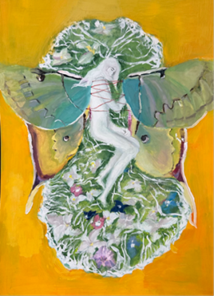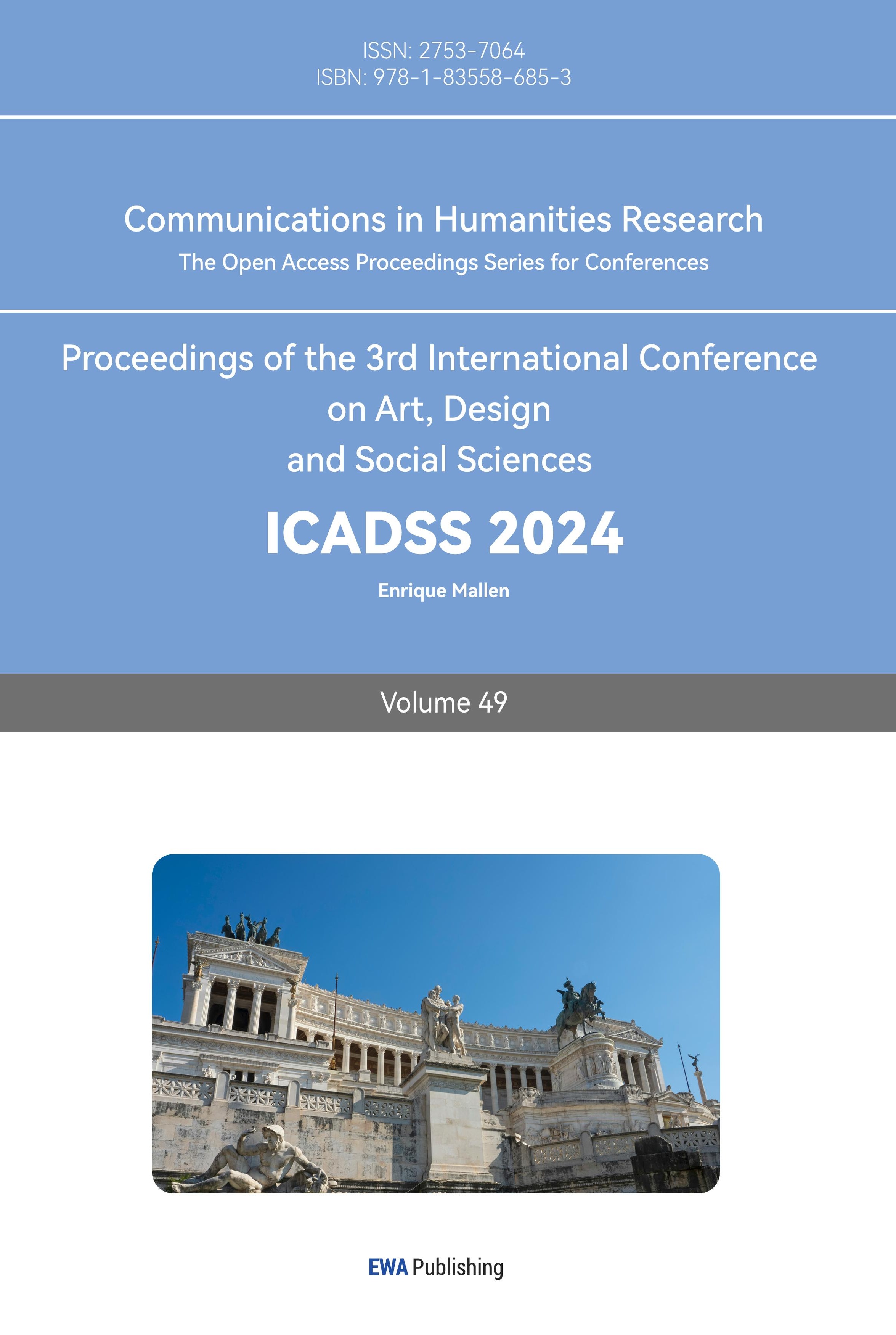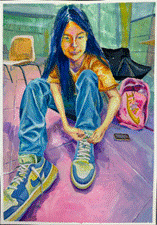1. Introduction
In today's deepening globalization, international schools serve as important platforms for cross-cultural communication and integration, bringing together students from different countries and regions, each with their unique cultural backgrounds, life experiences, and personality traits. Art, especially painting, is an intuitive way to express oneself, convey emotions, and showcase creativity, and its style is often deeply influenced by the creator's inner world. Therefore, exploring the connection between the painting styles of high school students in international schools and their personality characteristics not only helps deepen the understanding of the psychological mechanisms behind artistic creation but also provides new perspectives and references for cross-cultural education, psychological counseling, and personalized teaching. In recent years, interdisciplinary research between psychology and art has been increasing, particularly studies on the relationship between artistic creation, personality traits, and psychological states, becoming a hot topic in academia. However, research focusing on high school students in the unique environment of international schools is still insufficient. The high school student population in international schools, due to its special cultural integration and high cross-cultural adaptability, may exhibit more complex and varied painting styles, providing new opportunities and challenges for research. This study selects the painting works of high school students in international schools as the analysis subjects, collecting a diverse and representative sample of students' paintings. By employing artistic analysis methods, the study conducts a detailed style analysis of the works, examining aspects such as composition, color, lines, and themes to summarize the distinctive painting styles of different students. The findings of this paper will help educators better identify students' personalized needs, allowing them to develop educational programs that align more closely with students' characteristics, thereby promoting the overall development of each student.
2. Classification of Painting Styles and Their Characteristics
2.1. Basic Characteristics and Forms of Representational Art Painting Style
The term "representational" has been used since the 14th century to define the part of art related to human figures or images that, even if distorted or deformed, still present a realistic depiction of the external world [1]. It is a painting style that accurately reflects the objective reality. The characteristics of representational art include the pursuit of visual realism, precise reproduction of realistic details, and the creation of an immersive experience. It is rich in narrative, guiding the audience to feel emotions and conflicts through scene and character development, thereby enhancing the artistic impact. At the same time, it serves a documentary function by recording the appearance of times, places, and events with high authenticity and objectivity, preserving precious historical materials and cultural heritage for future generations.
2.2. Basic Characteristics and Forms of Impressionist Painting Style
The Impressionist movement retains a fresh perspective on urban streets, parks, and other subjects, showing great sensitivity to natural landscapes. It captures the "momentary" impressions of objects as they appear under different lighting conditions through changes in light and color. The artists of the Impressionist movement are a group of "unconventional" individuals who prefer to define things for themselves, rejecting the conventional. They do not create popular works to win public favor, whether in painting or in other endeavors [2].
2.3. Basic Characteristics and Forms of Abstract Art Painting Style
As a symbolic movement of modern art, abstract art emerged in the early 20th century, creating a unique category of art that is entirely different from traditional representational art. Abstract art opposes the imitation of real objects and calls for a departure from this imitation to establish a broader vision with bold expressions in form and color, embodying a sense of avant-garde. The birth of abstract art stems from a distortion and transformation of the real world. It can be said that abstract art is part of the development process of Eastern traditional representational art (as well as African art) and has absorbed some styles from the primitive art movement [2].
The Abstract Expressionist movement seeks an artistic world that departs from reality, focusing on the abstract expression of environment, atmosphere, and spirit. This often creates a sense that is both transparent and opaque, grounded in idealism, and sometimes draws inspiration from musical works. Additionally, the movement values the practical experience of creating artworks, emphasizing the fundamental principles and rules of modern fine arts and the careful selection of materials for painting.
3. Psychological Characteristics of Personality of International High School Students: Artwork Analysis
The Myers–Briggs Type Indicator (MBTI) is a personality type classification theory model proposed by American psychologists Isabel Briggs Myers and her mother, Katherine Cook Briggs. This model is based on the eight personality types classified by Swiss psychologist Carl Gustav Jung and aims to systematically categorize and describe individual personality traits [3].
The psychological characteristics of personality of high school students in international schools are a complex and multidimensional topic, encompassing their cultural backgrounds, self-perception, academic abilities, social relationships, and emotional development. This analysis combines the MBTI framework to provide a deeper understanding of individual personality traits and psychological preferences, serving as a tool for rapid self-awareness aimed at revealing different psychological preferences in perception and decision-making, helping individuals quickly understand their personality types.
In "Psychological Types", Jung classifies personality types, including two attitudes: Extroversion (E) and Introversion (I), as well as four psychological dimensions: Thinking (T), Feeling (F), Sensing (S), and Intuition (N). The combinations of different attitudes and functions yield eight distinct personality types, which can be further arranged to produce 16 different psychological types.
a. Energy Source:
- Extroversion (E): Tends to gain energy from the external world, and enjoys socializing, interacting, and expressing.
- Introversion (I): Tends to gain energy from the internal world, and enjoys solitude, reflection, and introspection.
b. Focus of Attention:
- Sensing (S): Focuses on reality, concrete details, and prefers to perceive the world through the senses.
- Intuition (N): Focuses on abstraction, possibilities, and the future, preferring to use intuition to perceive the essence of things.
c. Decision-Making Style:
- Thinking (T): Makes decisions based on logic and analysis, valuing objectivity and fairness.
- Feeling (F): Makes decisions based on emotions and values, valuing interpersonal relationships and harmony.
d. Attitude Toward Life:
- Judging (J): Prefers a planned, organized life, inclined toward control and structure.
- Perceiving (P): Prefers a flexible, spontaneous life, inclined toward adaptability and change.
When analyzing the personality characteristics of creators, we first need to clarify the definitions of "I types" and "E types." In the Myers-Briggs Type Indicator (MBTI), "I" (Introverted) represents introversion, tending toward solitude, deep thought, and the internal world; "E" (Extroverted) represents extroversion, tending toward socializing, expression, and the external environment. However, it is quite challenging to accurately determine an author's personality type (I or E) based solely on the content of a single artwork, as the meaning of art is often multilayered and can be influenced by various factors such as personal experience, cultural background, and creative motivation. Nevertheless, we can attempt to extract some clues from the artwork that may point to the author's personality traits.
The following discussion will explore works with the common theme of "Self-Portrait", analyzing pieces from extroverted students (MBTI measurement-E) and introverted students (MBTI measurement-I), along with an analysis of student artworks.
3.1. Analysis of Extroverted Students’ Works (E types)
As shown in Figure 1, this artwork uses bright colors to create a lively and cheerful atmosphere. This use of color reflects the author's positive and optimistic attitude toward life, as well as their unique perception and pursuit of color and beauty. The author is a cheerful and vibrant person with a rich imagination, enjoying free-spirited expression and using color to convey their emotions and inner world.
Figure 1: "Preparing Girl"
The vivid image of the girl occupies most of the composition, which, in terms of art psychology, reflects a relative confidence in oneself. The portrayal of the girl is lifelike; her expression, movements, and clothing details reveal the author's deep affection and attention toward her. This indicates that the author is a caring and compassionate person, capable of keenly perceiving the emotions and needs of others and expressing them through art.
3.2. Analysis of Introverted Students’ Works (I types)
The artwork in Figure 2 depicts a tranquil and harmonious scene, where a figure rests or contemplates on large green leaves, surrounded by flowers and small animals, with a warm yellow background. This scene may reflect the author's longing for an inner world of peace and a quiet life, or it could express their love and appreciation for the beauty of nature.

Figure 2: "Stitching"
If this tendency is linked to the MBTI personality types, the exploration and expression of the inner world, as well as a love for nature and tranquility, may lean more toward introverted (I type) characteristics. Introverted individuals often seek inspiration and fulfillment within their inner world, enjoying solitude and quiet moments, with a keen sensitivity to nature and subtle emotions.
4. Correlation between Different Painting Styles and Psychological Characteristics of Personality of International High School Students
The following discussion will explore the correlation between different painting styles and the psychological characteristics of personality of international high school students from the perspectives of color, lines, and composition. This paper primarily focuses on the E types (extroverted) and I types (introverted) in the MBTI framework.
4.1. Personality Traits Reflected through Color
Different colors evoke various emotional effects, and each color carries its own symbolic meanings, which are associated with different emotions and concepts that influence people's psychology and feelings. Furthermore, colors can provide a strong emotional impact; seemingly simple visual elements can effectively convey information and feelings, significantly shaping how people perceive the world. They also serve as tools for cultural and emotional communication [4].
E types (Extroverted): The colors in their artworks may tend toward bright, vivid, and high-contrast hues, such as sunshine yellow, vibrant orange, or bold red. These colors can convey warmth, energy, openness, and sociability. E types' artworks are likely full of energy, using colors boldly and directly, reflecting their sociable, thrill-seeking nature.
I types (Introverted): In contrast, I types’ artworks may feature softer, more subdued colors, such as gentle blues, tranquil greens, or soft pinks. These colors often convey calmness, contemplation, and introspection, aligning with the I type's tendencies toward solitude and deep thought. Their use of color may be more delicate, emphasizing harmony and balance between colors, reflecting their pursuit of inner peace and profound feelings.
4.2. Personality Traits Reflected through Lines
In painting, beyond the colorful and bright use of color, simple and clear lines stand out. Lines are one of the most important forms of expression in art beyond color; they form shapes, create figures, and establish layouts. Every artwork relies on the combination of lines; one could say that without lines, there is no painting [5].
E types: Their lines may be more fluid and free, sometimes conveying a sense of dynamism, such as curves, wavy lines, or rapid, powerful straight lines. These lines can express the extroverted, lively, and unconventional characteristics of E types. Their lines are likely to be full of variation and vitality, reflecting their expressiveness, love for adventure, and pursuit of novelty.
I types: Their lines might be more delicate and gentle, featuring fine curves, smooth straight lines, or intricate detail lines. These lines convey an introverted, refined, and contemplative quality, aligning with the I type's sensitivity and attention to detail. Their lines may focus more on internal logic and order, reflecting their inclination toward inner harmony and perfection.
4.3. Personality Traits Reflected through Composition
From a psychological perspective, exploring and studying composition allows for innovation, and the development of modern aesthetic theories, and enhances our artistic practice. This leads to a more comprehensive and dialectical understanding of the significance of composition in artistic creation, prompting reflection on the essence of composition. Ultimately, researching the essence of painting composition helps us fully utilize the diverse materials around us, combining the creator’s unique factors to more effectively grasp and apply creative techniques, resulting in more impactful artworks [6].
E types: Their compositions may be more open and expansive, with elements dispersed throughout the canvas, leaving ample space for viewers to feel a sense of freedom and unconstraint. This compositional style reflects E types' sociability, willingness to share, and pursuit of freedom. Their artworks may be vibrant and dynamic, guiding viewers into a positive emotional state.
I types: Their compositions may be more compact and focused, with internal connections and correspondences between elements, creating an inherent logic and order. This compositional approach reflects the introspective, thoughtful nature of I types, who emphasize their inner world. Their works may pay more attention to detail and emotional expression, using intricate composition and color application to convey deep emotions and thoughts.
Thus, there is a certain correlation between different painting styles and the personality psychological characteristics of high school students. However, it should be noted that the above analysis is merely a generalized exploration and cannot fully and accurately reflect the specific traits of every E or I type. Each individual's artistic creation is unique and influenced by various factors.
5. Conclusion
Through an in-depth study of the painting styles and psychological characteristics of personality of international high school students, this paper has drawn the following main conclusions: First, the research found a significant correlation between high school students' painting styles and their personality psychological characteristics. Second, art activities promote personal development, providing students with ample space to showcase and develop their individuality. During the painting process, students need to employ imagination, creativity, and critical thinking. These activities not only help students master painting techniques but also facilitate the maturation and diversification of their personalities. Third, the study also discovered that art holds significant therapeutic value for students' mental health. The process of painting serves as a psychological healing journey, helping students express negative emotions, stabilize and regulate psychological stress, and promote mental well-being. This paper primarily analyzed E types and I types in the MBTI framework, but it did not delve deeply into other personality types (such as J types, P types, etc.). Based on the above conclusions, future research could further explore the application of art therapy in the mental health education of high school students in international schools.
References
[1]. E. Laino, Methods of Art Appreciation, Beijing Publishing Group, Beijing Art Photography Publishing House, 1st edition, June 2016, 2nd printing, September 2017, p. 372.
[2]. G. Badolino, Methods of Art Genre Appreciation, Beijing Publishing Group, Beijing Art Photography Publishing House, 1st edition, June 2016, 3rd printing, December 2017, pp. 10, 76.
[3]. Zhao, Y. Analysis of the MBTI Testing Trend from the Perspective of Communication Psychology [D]. Shanxi: Shanxi University School of Journalism, 2024: 88-90 + 94.
[4]. Ren, J. Application and Effect Analysis of Color Psychology in Junior High School Art Education [D]. Gansu: Lichuan Middle School, Dangchang County, Gansu Province, 2024: 148-150.
[5]. Heng, Y. Exploration of Early Childhood Art Education Models Based on Children's Art Psychology [D]. Shaanxi: Leijiaxiang Kindergarten, Hantang District, Hanzhong City, 2021.
[6]. Zhang, H. Psychological Discussion of Traditional Composition Principles [D]. Anhui: Anhui Television Station, 2010: 20-21.
Cite this article
Wang,J. (2024). Research on the Correlation Between the Painting Styles and Psychological Characteristics of Personality of International High School Students. Communications in Humanities Research,49,57-62.
Data availability
The datasets used and/or analyzed during the current study will be available from the authors upon reasonable request.
Disclaimer/Publisher's Note
The statements, opinions and data contained in all publications are solely those of the individual author(s) and contributor(s) and not of EWA Publishing and/or the editor(s). EWA Publishing and/or the editor(s) disclaim responsibility for any injury to people or property resulting from any ideas, methods, instructions or products referred to in the content.
About volume
Volume title: Proceedings of the 3rd International Conference on Art, Design and Social Sciences
© 2024 by the author(s). Licensee EWA Publishing, Oxford, UK. This article is an open access article distributed under the terms and
conditions of the Creative Commons Attribution (CC BY) license. Authors who
publish this series agree to the following terms:
1. Authors retain copyright and grant the series right of first publication with the work simultaneously licensed under a Creative Commons
Attribution License that allows others to share the work with an acknowledgment of the work's authorship and initial publication in this
series.
2. Authors are able to enter into separate, additional contractual arrangements for the non-exclusive distribution of the series's published
version of the work (e.g., post it to an institutional repository or publish it in a book), with an acknowledgment of its initial
publication in this series.
3. Authors are permitted and encouraged to post their work online (e.g., in institutional repositories or on their website) prior to and
during the submission process, as it can lead to productive exchanges, as well as earlier and greater citation of published work (See
Open access policy for details).
References
[1]. E. Laino, Methods of Art Appreciation, Beijing Publishing Group, Beijing Art Photography Publishing House, 1st edition, June 2016, 2nd printing, September 2017, p. 372.
[2]. G. Badolino, Methods of Art Genre Appreciation, Beijing Publishing Group, Beijing Art Photography Publishing House, 1st edition, June 2016, 3rd printing, December 2017, pp. 10, 76.
[3]. Zhao, Y. Analysis of the MBTI Testing Trend from the Perspective of Communication Psychology [D]. Shanxi: Shanxi University School of Journalism, 2024: 88-90 + 94.
[4]. Ren, J. Application and Effect Analysis of Color Psychology in Junior High School Art Education [D]. Gansu: Lichuan Middle School, Dangchang County, Gansu Province, 2024: 148-150.
[5]. Heng, Y. Exploration of Early Childhood Art Education Models Based on Children's Art Psychology [D]. Shaanxi: Leijiaxiang Kindergarten, Hantang District, Hanzhong City, 2021.
[6]. Zhang, H. Psychological Discussion of Traditional Composition Principles [D]. Anhui: Anhui Television Station, 2010: 20-21.










